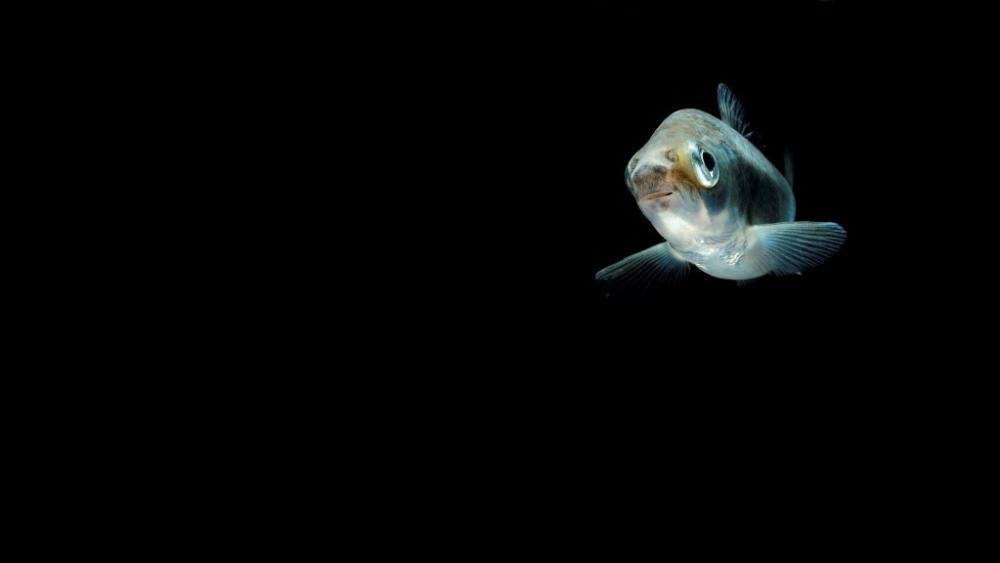
A bold fish? You can't tell from the tip of their nose, but fish can show different levels of activity or aggression and react differently to new environments or risk situations. Thus, the personality of a fish has ecological and evolutionary consequences. | Photo: Solvin Zankl
Dr. Mehner, the pace-of-life syndrome is hotly debated among scientists, but otherwise little is known about it. What exactly does the hypothesis imply, and why did you decide to make it a subject of IGB research?
Thomas Mehner: The fascinating thing about the pace-of-life syndrome is that basic theories from the fields of ecology, physiology and behavioural research were integrated into one single concept. This concept implies that an individual’s metabolic activity, life history and behavioural patterns are interdependent and inter-related. Active, risk-prone individuals require a lot of energy; the interlinking of physiology and behaviour means that active individuals often reproduce earlier and have shorter lifespans. Slow, risk-averse individuals need less energy, and are therefore expected to reproduce later and have longer lifespans. We wanted to test this concept, asking ourselves: do these systematic differences among individuals exist regardless of their habitat? Do certain environmental variables only influence individual parts of the pace-of-life syndrome or the entire syndrome?
What exactly did you investigate?
We compared two populations of a fish species originating in very different conditions: the first mosquitofish population was taken from a pond that was regularly harvested, with around 80 per cent of adult individuals being taken each time, mimicking enormous predation pressure. The second mosquitofish population inhabited an undisturbed quarry. We maintained 40 first-generation progeny of each population of fish under identical conditions, and monitored their behaviour for six months, i.e. across all development stages.
And what did you find out?
It was remarkable that we were unable to assign particular behavioural types to early juvenile fish. Their behavioural patterns were not repeated each day. This changed as they got older; the behavioural spectrum became narrower, and easily distinguishable types evolved. After around three months, the mosquitofish had found their “personality”, and variability in their own behaviour decreased. As expected, the populations differed in line with their variation in life history. The population from the quarry grew slowly and reproduced later, while the population harvested from the pond grew faster and reproduced earlier.
And did this confirm the pace-of-life hypothesis in the comparison between populations?
No. The dispersion of behavioural types in the comparison between populations should have differed markedly, because their environmental conditions differed considerably. The example of metabolism is striking: according to the hypothesis, animals are only bold and active if they eat a lot and allocate relatively few resources to reproduction, because an active life is very energy-intensive. We were able to confirm this for the slow-growing fish, offspring from the quarry lake. However, the fast-growing offspring from the heavily fished pond did not fit this pattern: despite being large with a high energy turnover, the fish were not bold.
What explanation do you have for this?
We have a hunch: as soon as there is strong selection pressure on an axis of the pace-of-life syndrome, it breaks, and the predicted correlations no longer exist. We do not know why that is, but predation pressure may well play a major role. One thing is for sure: the syndrome does not apply under all selection conditions.
You and Giovanni Polverino’s project team had originally set out to find further confirmation of the pace-of-life syndrome. That was not the case – quite the contrary. What conclusion can be drawn from this?
Even celebrated constructs must be challenged. Sometimes biologists want to be like physicists, defining simple rules that apply everywhere. This is why the hypothesis caused such a sensation in the community: it was fascinating to formulate a cross-thematic theory for individuality. I, too, thought that we would find what we had expected. I was certain that the two populations would differ, but that the traits of individuals would develop in correspondence with the pace-of-life syndrome. I never thought that it would not be the case for one population.
When did you realise what had happened?
When Giovanni showed me the schematic diagram reflecting the correlations between behaviour, physiology and life history. This interaction was apparent with the slow-growing fish, but not with their fast-growing counterparts. I thought there must be an error, that something had been calculated wrongly. But everything was correct, and we were delighted to have proven that the pace-of-life syndrome does not apply under all conditions. Because it now opens up another door, and we can ask: why is this not the case? There will certainly be more research on this aspect.
The interview was conducted by Wiebke Peters.
Read the study Open Access in Scientific Reports >
Giovanni Polverino, Francesca Santostefano, Carlos Díaz-Gil, Thomas Mehner (2018). Ecological conditions drive pace-of-life syndromes by shaping relationships between life history, physiology and behaviour in two populations of Eastern mosquitofish. Scientific Reports, 8, 14673. doi:10.1038/s41598-018-33047-0





